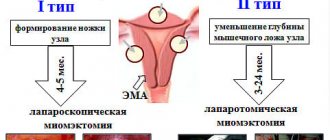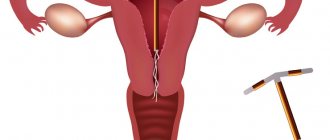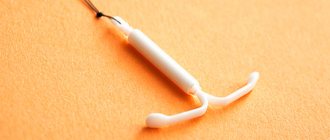Removal of an IUD is a gynecological procedure, the purpose of which is to remove the IUD from the uterine cavity. It is performed by a gynecologist on an outpatient basis: he either pulls it out by the “antennae” or uses a special tool if the first is not available. It is prohibited to remove the contraceptive yourself, since the procedure can cause damage or infection of the uterine endometrium with the subsequent development of serious complications.
Removal of the IUD is one of the list of services of the gynecological department of CELT. Our multidisciplinary clinic has been operating in the paid medical services market in Moscow for more than a quarter of a century. The gynecology department is staffed by leading Russian specialists who have decades of experience in scientific and practical work. They have a powerful diagnostic and treatment base that allows the IUD to be inserted/removed safely for a woman. You can find out the price of IUD removal in the price list, in the “Services and Prices” section. Despite the fact that we regularly update our price list, we recommend that you check the numbers during a consultation with a doctor or operator.
Kinds
Today, 2 types of intrauterine device are actively used:
- Copper IUD. A copper coil inserted into the uterus releases copper ions, acidifying the uterine environment and reducing sperm activity. The lifespan of a copper IUD is no more than 10 years.
- Hormonal IUD. After administration, the hormone progesterone is released. This hormone is released daily and inhibits egg maturation. You can use it for up to 5 years, then the spiral is changed.
In appearance, both pregnancy coils resemble the letter T, at the end of which there are two small antennae.
Types of intrauterine devices
In addition to its main function, uterine devices protect against inflammatory diseases.
What is a female spiral
The intrauterine device is the most popular and most effective type of female contraceptives at the moment.
This phenomenon is explained quite simply: first of all, you just need to install this IUD and that’s it, next time you just need to remove it at the end of the period of use, that is, you don’t have to constantly worry about not missing or forgetting to take it for contraception, as is the case with hormonal pills. And of course, the IUD is very effective and reliably protects against unwanted pregnancy. There are two types of intrauterine devices: hormonal (Mirena) and containing metal; as a rule, they are coated on top with copper, silver or gold. The intrauterine devices themselves have a size of 3x4 centimeters, in most cases they look like the letter “T”, since this is the shape that is closest to the structure of the uterus.
Indications
As noted above, the benefit of the IUD is not only the inability to get pregnant. The spiral is indicated for the treatment of various diseases, such as:
- Problems with menstruation. Painful, difficult periods, irregular menstrual cycle, etc.;
- Pelvic pain;
- Uterine fibroids and endometriosis. Early endometrial cancer and precancerous condition;
The spiral produces a bactericidal effect, therefore it alleviates the condition of the disease and prevents deterioration.
The intrauterine device is highly recommended for women who have given birth and do not have STDs or cervical diseases.
Various complications
The most common period after the installation of an IUD when various complications appear is the first three months.
Spiral falling out. It is not necessarily accompanied by painful sensations and does not cause harm to the body. Sometimes a woman does not notice at all that the spiral has fallen out. Loss can occur either immediately after the procedure or for quite a long time after the insertion of the IUD. The cause of the IUD falling out can be heavy physical exertion and deformation of the cervix. Also, if an incompetent doctor installed the IUD incorrectly or chose an IUD that is unsuitable in size and type for the body. Sometimes prolapse occurs due to the harmless reason that the body does not accept a foreign object. In this case, after getting used to it, everything goes away.
Uterine bleeding - Bleeding from a woman’s uterus is not always dangerous. If there is bleeding after installing the coil, first of all you need to pay attention to the volume and timing of bleeding. If small amounts of blood are released over the course of several months, this is completely normal. You should consult a doctor if, after installing the IUD, heavy bleeding begins and continues for more than seven days, with severe pain. The doctor will prescribe treatment and determine whether to remove the IUD during treatment or not.
Perforation of the uterus. This complication occurs very rarely, but it does happen. If inserted incorrectly, the IUD damages the uterus. Other causes of perforation are the incorrect shape of the spiral, its type, or the spiral that is not suitable for the anatomical features of the uterus. After treatment of perforation, the IUD is not recommended for further use as a means of contraception.
Menstruation after installation of the IUD
In fact, everything will depend on the installed spiral. For example, with the introduction of metal-containing IUDs, menstruation will change as follows:
- the amount of blood released increases, and the duration of menstruation also increases. Often, but not always, women notice that pain increases during menstruation;
- before menstruation, after and between menstruation, bloody spotting begins to appear.
But don’t be scared, because these unpleasant symptoms appear only from three to six months from the moment of installation. Then they pass, and the menstrual cycle returns to normal. But if menstruation with the IUD comes irregularly, and severe pain occurs, then the IUD must be removed urgently.
The nature of menstruation after the installation of a hormonal IUD in most cases is fundamentally different from the changes that occur after the installation of non-hormonal ones containing metal. Most often, menstruation becomes shorter in time, and the discharge itself becomes more scanty. Often women notice delays, and in 20%, periods disappear altogether. This happens because the IUD, which contains hormones, suppresses the development of mucous tissue in the uterus.
Don’t be alarmed; your periods will return after the IUD is removed from the body. These changes are actually harmless; on the contrary, they improve a woman’s life. For example, the Mirena hormonal device is used to treat intrauterine bleeding.
Why does bleeding occur?
Light bleeding and scanty brownish smears for six months after insertion of the IUD are a natural phenomenon and should not bother a woman. In this case, bleeding after insertion of the spiral is the body’s adaptation to the foreign object. You need to see a doctor if the smears continue and do not stop for 8 months or more, and if after installing the IUD, bleeding continues for a long time or severe bleeding occurs.
Often in the first month after the procedure, girls experience a delay in menstruation. In this case, anti-inflammatory drugs are taken that normalize the cycle and protect against inflammatory processes in the uterus. Inflammation of the uterus occurs due to intolerance to the IUD as a type of contraceptive.
Removal of an IUD in gynecology
An IUD is an intrauterine contraceptive, a gynecological product that has a special shape. Today there are more than fifty varieties of it on the market, so the selection should be made by a gynecologist after examining and diagnosing the patient. The insertion of an IUD is a surgical procedure that prevents the patient from becoming pregnant for five to ten years. The effect is achieved by:
- The rapid movement of the egg through the fallopian tubes, which prevents its fertilization, causing it to enter the uterine cavity in an unformed state;
- Changes in the chemical environment of the uterine cavity and the inhibitory effect on sperm, due to which their activity decreases;
- The formation of an air plug, which significantly complicates the entry of seminal fluid into the uterine cavity;
- Creating a mechanical obstacle that prevents a fertilized egg from implanting into the uterine mucosa.
The operation to remove the IUD can be performed at any time at the request of the patient. Within twelve months after it, she can become pregnant. In addition, it must be removed after its validity period has expired, due to inflammation of the genitourinary system or its displacement.
What to do if there is heavy bleeding
If there is heavy or prolonged bleeding after the IUD insertion procedure, you should immediately go to the hospital. The doctor prescribes tests and examination. The first thing the doctor will pay attention to is whether the woman has gynecological diseases. If the woman’s blood flow does not stop and there are no serious illnesses, the coil is removed, otherwise a complication may arise in the form of iron deficiency anemia. During treatment, the patient is regularly examined and monitored for the course of the disease.
To prevent symptoms, the doctor prescribes medications containing iron and recommends eating more foods that are rich in iron.
Consultation with a gynecologist is mandatory
Other complications
Common complications from starting to use an IUD are heavy bleeding and the IUD falling out at different times. But there are other, more rare complications.
The majority arises, as a rule, from a copper spiral.
- Too painful menstruation;
- Blood clots during menstruation;
- Pelvic infections;
- Damage to the uterus by the coil;
- Irregular periods. Sometimes they disappear completely;
- Ectopic pregnancy, miscarriage, subsequent early birth.
Infertility. It is because of this complication that doctors recommend using spirals only for women who have given birth.
Spiral shapes
There are only three main forms of the IUD, and each of them has its own characteristics:
- T-shaped. This form of IUD is the most popular among the female population. They themselves are very convenient and are also easy to install and remove. This IUD looks like a rod from which two flexible tendrils, or shoulders, extend. Due to these hangers, the spiral is attached inside the uterus. A thread is attached to the bottom of the rod, with which the gynecologist can remove the spiral.
- In the form of a ring. A modern form of IUD, which is recommended primarily for women who have had an abortion. It is made of plastic and contains silver, gold or copper. This IUD attaches well to the uterus and is also easy to remove, and therefore the presence of a string on them is not mandatory.
- Loop or umbrella. The umbrella-shaped dome on the outside has notches, similar to spikes, with their help the IUD is attached to the uterus, without threatening to fall out at the wrong moment. This type of IUD is usually used when the uterus has a non-standard shape, into which it is impossible to install the most common T-shaped intrauterine device.
Installation
Before going to the IUD insertion procedure itself, you need to carry out a number of preparatory measures: take tests prescribed by the doctor, undergo an examination by a gynecologist and carry out the procedure.
Examinations that must be completed before the procedure:
- Pregnancy testing;
- Taking HIV tests;
- Screening for STDs and other gynecological problems;
- Blood test for hepatitis C and other types;
- The doctor must examine the genital organs: vagina, uterus, etc. and then select the best type of IUD for the woman.
Before the procedure, the gynecologist measures the size and depth of the uterus. The process of installing an intrauterine device feels like inserting a gynecological speculum during an examination. There is no severe pain during the procedure, but there is some discomfort. If a woman does not tolerate the slightest discomfort, the doctor may inject painkillers into the cervical area. Installing the spiral takes 10 minutes.
Correctly inserted IUD
What to do
Copious or prolonged scanty, short-term and massive bleeding requires immediate contact with a gynecologist. Especially if there is an unpleasant odor from the vagina, severe pain in the lower abdomen, and body temperature rises.
To establish the cause of violations, you must:
- undergo a gynecological examination to determine whether the IUD is installed correctly;
- If you suspect the activation of a chronic infection or the addition of a secondary infection, do a microflora analysis.
Depending on what triggered the development of pathological bleeding, the doctor may prescribe anti-inflammatory drugs (Nimesil, Ibuprofen, Naklofen, etc.).
For bacterial infections, antimicrobial therapy may be necessary. For this purpose, broad-spectrum antibiotics are used. In the future, an analysis should be carried out to determine the sensitivity of microorganisms to the action of antibacterial agents.
In complex treatment, antiseptic drugs (Miramistin, Betadine) and agents for restoring normal microflora (Gynocomfort, Gynoflor, etc.) are used.
Rehabilitation
After installing an intrauterine device, you need a gentle daily routine, more rest, and you cannot strain yourself too much with work. The spiral is a foreign object for the body; it takes some time to get used to it and the body experiences stress, so extra stress during rehabilitation will only aggravate the condition. The rehabilitation period after installation of the IUD is different for all women. If there is no pain or heavy bleeding, you can perform the usual amount of work. Just don’t forget that any overvoltage can cause problems, the most common of which is the coil falling out.
Since the prolapse of the IUD from a woman’s uterus most often occurs during the first 8 months, a verification procedure must be carried out. The position of the spiral can be determined by the antennae. You can check this yourself with your fingers, but if a woman cannot check it herself, you need to entrust the matter to a gynecologist. You need to be examined by a doctor monthly. Then the dangerous period will pass easily and without complications.
The principle of operation of the uterine device
The IUD has many advantages:
- Small price.
- After removing the IUD from the body, reproductive capacity is quickly restored.
- Can be used even while breastfeeding.
- A very high degree of contraception, can be compared with a condom, as it prevents unwanted pregnancy by 98%.
- Unlike the same hormonal pills, a woman’s hormonal levels do not change
- The spiral can be taken for a very long time, from 3 to 10 years.
- Installation and removal is straightforward.
- It does not cause discomfort and is not felt either in everyday life or during sexual intercourse.
- There is no need for oral contraceptives.
When choosing an intrauterine device, the doctor relies on the physical condition of the patient and the unique structure of the uterus. There are now more than 50 different types of devices. They were not improved immediately, but gradually, so intrauterine devices have 4 generations at once. Let's look at them all in more detail.
- 1st generation. Inert. These are the very first intrauterine devices; they were invented about a century ago. Of course, these are the very first coils, and therefore have very low efficiency, and can easily move or even fall out, which is why such devices have been banned in many countries around the world. The brightest and most famous representatives: the Lipps loop, made of plastic in the shape of the English letter S; Mauch's ring, made of steel and has two scrolls; Saf-T-Coil spiral, double; Dalkon's shield.
- 2nd generation. Copper. A semi-oval or T-shaped device, the main rod is wrapped around a copper wire. It is very easy to put on and take off. Due to the presence of copper, an acidic environment is formed in the uterus, which kills all sperm activity. Such contraceptives are prescribed for a period of 3 to 5 years. The most popular models of spirals are: Multiload, Nova T, Juno Bio and Para Grand.
- 3rd generation. Silver. To extend the service life of contraceptives and delay the oxidation of the metal, in the third generation of IUDs they began to use silver instead of copper. But these are not all the advantages of silver IUDs over copper ones. Improved spirals have even stronger protection and, in addition, silver ions have a beneficial effect on the female body, as they have an antibacterial and disinfectant effect. Contraceptives made of silver or silver with an admixture of copper have a validity period of 5 to 7 years. Gold intrauterine devices also belong to the 3rd generation and are an alternative to silver and copper IUDs and are an improved version of them.
- 4th generation. Hormone-containing. Doctors consider this generation of IUDs the best remedy for unwanted pregnancy. These spirals are also shaped like the letter “T”, but on its stem, instead of a metal spiral, there is a hormonal drug, progesterone or levonogrestrel, and it is gradually and evenly released into the uterus. This method of contraception has no contraindications, because the hormones do not reach the blood, having only a local effect, slowing down ovulation, while relieving inflammation, and, of course, does not allow you to get pregnant. These IUDs are used for only 5 or maximum 7 years.
The metals that the intrauterine device contains are very harmful to sperm. An IUD produces a viscous, thick mucus that traps sperm, preventing them from reaching the egg. Devices containing hormones suppress ovulation in principle. And if fertilization does occur, then the spiral increases contractions of the uterus, the egg dies because of this, and pregnancy does not occur.
Spirals, of course, have disadvantages, and there are only three of them:
- with the IUD, unlike using a condom, there is no protection against sexually transmitted infections;
- Only a doctor can insert and remove the spiral;
- After installation of an intrauterine device, side effects may occur.
Intrauterine devices are one of the safest contraceptives in terms of side effects, since in 95% of cases the use of an IUD occurs without any complications. However, extremely rarely, the development of endometritis and uterine perforation can still occur.
When to see a doctor
Slight spotting or spotting is a natural reaction of the body after insertion of the IUD, as it occurs in almost all women. The average period is 6 months, but the time for cessation of discharge varies individually and can vary from 4 to 8 months. It happens that there is no discharge at all, but this is very rare and harmless.
Only prolonged and heavy discharge becomes dangerous. It's like having a period that doesn't stop for several weeks. If there is heavy bleeding, you should immediately consult a doctor. Also, if the discharge continues for quite a long time, it is better to visit the hospital, since severe bleeding and smears for more than 8 months can be caused by serious disorders in the body.
Sometimes the IUD in a woman can provoke various diseases of the uterus, then bleeding signals inflammation. If the examination reveals a negative effect of the spiral, it is removed and no longer installed. In this case, other methods of protection are prescribed.
Read more about the IUD and its effect on the reproductive system
Giving a thicker consistency to the mucus produced by the cervix. Thanks to this, it is difficult for sperm to enter the organ cavity;
- Interfering with the development of the endometrium in such a way that it becomes unsuitable for the attachment of the fertilized egg;
- Strengthening the motility of the fallopian tubes. This feature will ensure the rapid passage of a fertilized germ cell through them. It does not have time to mature to the state necessary for implantation.
The impact of the device is aimed at the organs directly involved in the process of menstruation. Therefore, menstruation with a spiral may have different parameters than without it.
Installation of the spiral
Only a doctor should insert an IUD after a thorough examination of the woman to ensure she is not pregnant. infectious diseases and inflammatory processes in the uterus. Since it must be located in the cavity of the organ, the natural question is: when is the IUD placed before or after menstruation?
Access to the uterine space is through the cervical canal. This is a rather narrow “corridor,” especially for nulliparous women. Traumatizing it is extremely undesirable, as it carries the risk of infection and the appearance of erosive changes. Damage to the cervix may be a negative circumstance for subsequent births.
It is more advisable to insert the IUD during menstruation:
- The cervix is slightly open more widely than usual and has a soft consistency;
- The insertion of the IUD will be precise and painless;
- The reproductive system is undergoing an update, which will help it quickly adapt to the presence of a foreign object.
But what about the discharge? Can't it interfere with the doctor? This consideration leads to the question of what day of menstruation the IUD is placed on. With a 3-day menstruation, it is better to do this on the last day.
If it lasts 4-7 days, it is also closer to the end, for example, 2-3 days before it. In this case, by the time the IUD is inserted, menstruation is no longer so intense as to prevent the gynecologist from seeing the working field.
But the cervix has not yet narrowed enough to make inserting the IUD difficult.
For some women, the doctor prescribes the installation in addition to their critical days. But they doubt whether the IUD is inserted without menstruation. In principle, doing this on other days of the cycle is not prohibited. It’s just that many specialists prefer to do the installation in the last days of menstruation. This way you can be sure that the patient is not pregnant.
But if there is urgency in protection, you should not be afraid and doubt whether it is possible to insert the IUD without menstruation. This is often done to women who have recently had a successful birth. In order for the hormonal IUD to work immediately, it is administered a week after the start of the cycle.
For many, their critical days are already over by this time, and the IUD is thus installed “dry”. The process may be a little more painful. But local anesthetics will help relieve the sensations, and the manipulation itself lasts no longer than 5 minutes.
Menstruation during the spiral should normally come on schedule. But since the body has suffered stress associated with its introduction, and also needs to adapt to the presence of a foreign object in the uterus, a slight delay is acceptable. It is also made possible by a shock to the nervous system, which provides hormonal accompaniment of the cycle.
In this case, if there is a spiral, a delay in menstruation is likely due to a deficiency of certain substances, which causes a prolonged wait. Its increase is facilitated by installation outside critical days. But the wait for menstruation should not be longer than 3 weeks. And when it exceeds this period, the woman urgently needs to see a doctor.
A short delay in menstruation with the IUD is not an alarming signal if it is observed only for 3-4 cycles. The period of adaptation may well be that long. When this happens for longer, it makes sense to consult a specialist.
If a woman has an IUD and has not had her period for a long time, then it is possible that conception has occurred. This probability is very small, but it should not be denied at all.
This also requires immediate consultation with a specialist. To avoid this, you should use other methods of protection for a couple of weeks after inserting the IUD.
The nature of menstruation in most women changes towards increased discharge and duration. The spiral makes heavy periods possible due to the irritating effect on the endometrium and changes in the composition of cervical mucus.
We must also not forget about unstable hormonal levels due to installation-related stress. The spiral makes the first menstruation be especially intense. A woman may need more than 1 pad for 3-4 hours. If she also feels severe pain and severe weakness, she may need medical help immediately.
But normally, menstruation, although it goes beyond what is usual for a particular woman, does not pose any danger. And even if the pain is stronger than before, it is relieved with antispasmodics.
During the remaining days of your period immediately after inserting the IUD, you should not use tampons. They increase the risk of infection in the internal genital organs and may interfere with adaptation to the spiral.
Gradually, the body restores hormonal balance, which brings menstruation after the introduction of the IUD to the usual norm for a particular woman. If their intensity remains at the level of the first menstrual cycle. this may indicate that the body does not accept this method of contraception or type of contraceptive.
When your period takes a long time. The coil was installed 1-3 months ago, there’s nothing wrong with it. This is a normal reaction of the reproductive system to a foreign object inside the uterus. Between menstruation at this stage, spotting with blood is possible. For now, this is also a sign that the reproductive system is getting used to the contraceptive. You shouldn't feel any pain.
At this stage, menstruation after installation of the device returns to the physiological norm. They may still be more abundant than usual, but they do not fall outside the acceptable range. Pain during menstruation also sometimes remains stronger than what was felt before the insertion of the IUD.
After the IUD, heavy periods and long periods of time during its 3-month stay in the uterus require consultation with a specialist. Most likely, the IUD will have to be removed, since the side effects from its presence exceed the contraceptive effectiveness. A woman may develop anemia and inflammation of the genital area.
Despite the reliability of the IUD, it happens that the IUD remains in place for 3 months and there are no periods at any stage, although they came immediately after insertion. Pregnancy in this case is possible even now, when the body, it would seem, has already adapted to the adaptation. The location of the fertilized egg outside the uterus is also possible.
Features of Mirena
What has been said about the nature of menstruation applies more to conventional IUDs, without the introduction of hormones into the uterus. The Mirena spiral has the ability to gradually introduce progestins into the organ. The contraceptive effect is achieved by thickening cervical secretions and interfering with the development of the endometrium. Therefore, menstruation with Mir does not occur differently than when using other IUDs.
Unlike non-hormonal IUDs, with Mirena, menstruation is less abundant than before its use:
- This is explained by the fact that levonorgestrel, which is secreted by it while in the uterus, prevents the endometrium from thickening in the proliferative phase of the cycle. Towards its end, the mucous membrane becomes even thinner;
- The hormone inhibits ovarian function, reducing the likelihood of ovulation;
- The body itself produces fewer substances that promote the growth of endometrial tissue;
- Intense menstruation after insertion of a hormonal IUD can occur only in the first months of using the device.
As a rule, after three cycles their number decreases by 80% compared to the previous volume. And for some women, menstruation completely disappears for a year.
Menstruation with the Mirena spiral is also characterized by less pain, since levonorgestrel reduces the contractility of the smooth muscles of the uterus. But between them, spotting may also occur for 3-6 months.
After Mirena
Menstruation after the Mirena IUD comes in 1-3 months. When the body is basically healthy, its functions in the reproductive sphere are restored quickly, therefore pregnancy after removal of the device can occur in the next cycle. Although you should avoid it for now.
But if the device has been in the uterus long enough, it may take longer for the levonorgestrel to come out than with a regular IUD.
Restoration of the functions of the endometrium, which is exposed to hormonal influences for a long period, can also take longer than 3 months. But the doctor will have to look for the reason for this and recovery methods.
Need for removal
There are many reasons why you need to remove the coil or replace it with a new one.
The need to remove the spiral may arise in the following cases:
- The hormonal intrauterine device needs to be changed after every five years of use, and the copper one after ten years.
- When using other protection against pregnancy, the IUD must be removed at the beginning of the menstrual cycle.
- After removing the intrauterine device, the next installation is made only after a month.
- If inflammation or infection occurs due to the coil, or if there is heavy bleeding, the coil must be removed.
- In case of individual intolerance to the IUD. If, when using an IUD, a woman has constant abdominal pain in the area of the uterus, or the blood of sexual intercourse experiences discomfort, the IUD must be removed and another method of protection must be used.
IUD removal protocol
The fifth to seventh day of the cycle is chosen for the procedure. If the procedure is standard and uncomplicated, no anesthesia is required. The gynecologist uses an instrument to grasp the tendrils of the IUD hanging from the endocervix and carefully removes it. If the antennae are not visible and cannot be captured, local anesthesia is used and instrumental removal is performed. To do this, the cervix is dilated and a hysteroscope is inserted into its cavity, which provides visual control over the procedure. Further actions depend on the position of the spiral. If she:
- lies in the cavity - it is taken out by grabbing it with a tool;
- has grown into the muscles of the uterus - curettage is performed and the tissue is sent for histological examination;
- grown into muscles near large blood vessels, bladder or ureter - removed through punctures in the abdominal cavity using laparoscopic access.
In severe cases, instrumental removal of the IUD can provoke perforation of the endocervix and the development of bleeding. If extraction was required due to inflammatory/infectious processes or the appearance of neoplasms, removal is accompanied by the collection of smears for histology. If necessary, the gynecologist will determine the negative consequences of using an IUD and develop tactics for their treatment.











